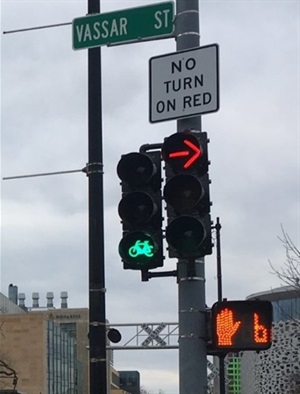Clement Ave Safety Improvements Project: FAQ
1. What are the new bicycle traffic lights?

Bicycle signals make crossing intersections safer for bicyclists by clarifying when the bicyclist should enter an intersection and reducing the instances of bicycle and vehicle interactions. Bicycle signals look like regular traffic lights with traditional three lens signal heads, but contain green, yellow, and red bicycle outlines.
A new bicycle traffic light was installed at Park Street along Clement Avenue by the two-way cycle track.
2. What do cyclists do when approaching an intersection with a bicycle traffic light?
 When approaching the intersection when the bicycle signal is red, cyclists will automatically be detected while they wait at the bicycle stop bar; there is no need to press a push button. That detection cues the traffic signal system to give the cyclist a green light.
When approaching the intersection when the bicycle signal is red, cyclists will automatically be detected while they wait at the bicycle stop bar; there is no need to press a push button. That detection cues the traffic signal system to give the cyclist a green light.
In addition to the new light on Park and Clement, there is an active bike signal at Sherman St. and Atlantic Ave. Be on the look out for future bike signals around Alameda.
3. What accommodations have been made for users who are disabled?
To align with the legal requirements of the United States Access Board, the Clement Avenue Safety Improvement Project provides new on-street disabled parking near intersections, curb ramp upgrades, and increased sidewalk width. You may notice these around utility poles where sidewalk width was previously too narrow. Approximately ten curb ramps have been upgraded or installed.
To learn more about ADA improvements, see the City of Alameda’s ADA Transition Plan.
4. What is a two-way cycle track?
The two-way cycletrack is It is a low-stress bike route, meaning bikes and cars interact significantly less than traditional bike lanes with no buffer, and are consistent with the City’s Active Transportation Plan.
5. What happens at a four-way stop when there is a two-way cycle track?
If two or more vehicles arrive at an intersection at the same time, the vehicle to the right should go first. This is also true for bikes approaching the cycle track, regardless of whether they are heading east or west, or whether they are turning or going straight. Vehicles, cyclists, and pedestrians should take extra caution at intersections with new safety treatments and familiarize themselves with the new layout.
The cycle track is protected by concrete hardscape. Along most of the bikeway, this is a plain 6” tall curb. At intersection and driveway openings, there is a shorter high-visibility red brick median island so road users can differentiate between the cycle track and the roadway.
6. How will the new mountable floating islands and red curbs increase safety?

To align with California’s new “daylighting” law (AB 413), the City is working to implement NO PARKING ZONES 20 feet from crosswalks. This law aims to improve pedestrian and vehicle safety.
The City has installed concrete islands at the southern corners of Clement Ave to improve sight distance. This will allow cars turning onto Clement or pedestrians crossing it to have an unobstructed view of the traffic on Clement Ave. Another word for this treatment is daylighting. Studies have shown that improving daylighting greatly improves safety at intersections. The figure to the right shows how the 20 foot clearance can make a big difference for street safety at painted and unpainted crosswalks (Source: SFMTA). Painted bulbouts and red curbs are being installed at intersections to further enhance sight distance and to prevent sharp turns around corners.
7. What do the new Bioretention Basins do?
Bioretention basins are being installed near Elm St and Broadway along Clement Avenue. These are shallow landscaped areas where some stormwater is collected and treated through physical, biological, and chemical processes before entering the storm drain system and eventually draining into the Bay. Their appeal is aesthetic and scientific!

Additional Information:
-
Clement Avenue Project Webpage
-
Subscribe to project updates
-
Direct questions or concerns to Michaela Wood, Engineering Assistant, by phone at 510-747-7935 or by email at mwood@alamedaca.gov. 如需中文协助,请致电 510-747-7972 进行预约。Rú xū zhōngwén xiézhù, qǐng zhìdiàn 510-747-7972 jìnxíng yùyuē. Para obtener asistencia en español, llame al 510-747-7939.
-
This corridor improvement project is funded by Measures B/BB, which are Alameda County's transportation sales tax measures, and a federal grant.